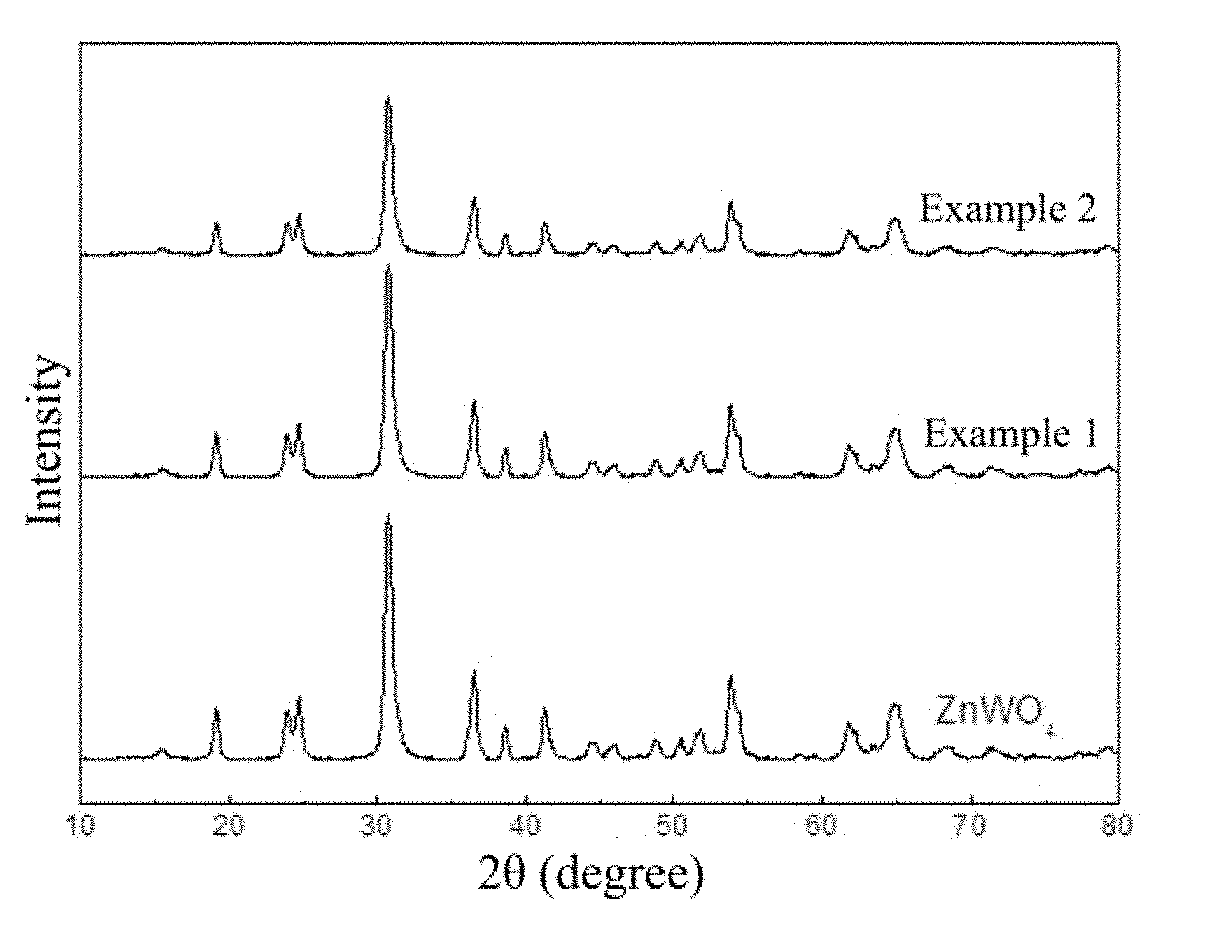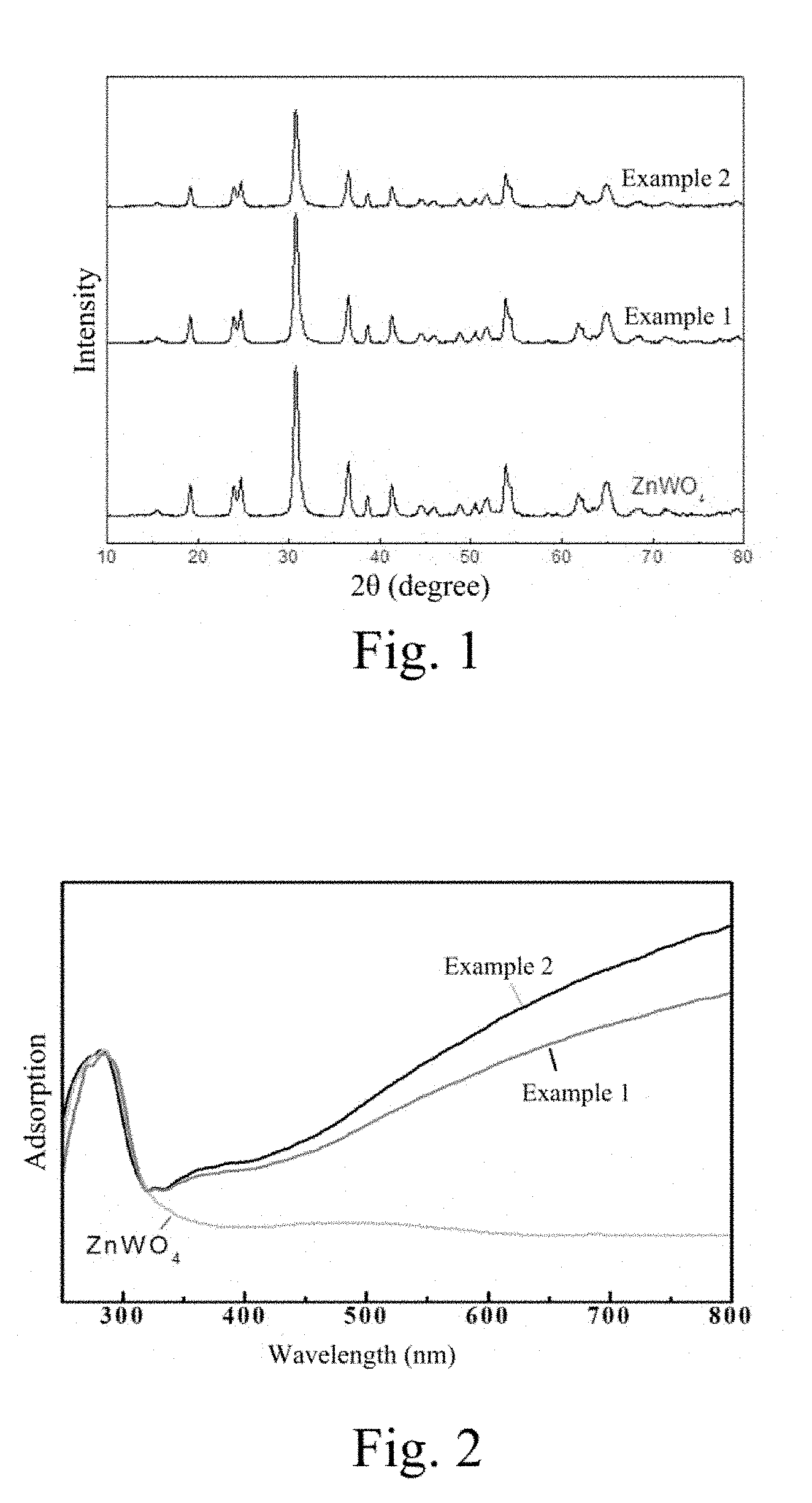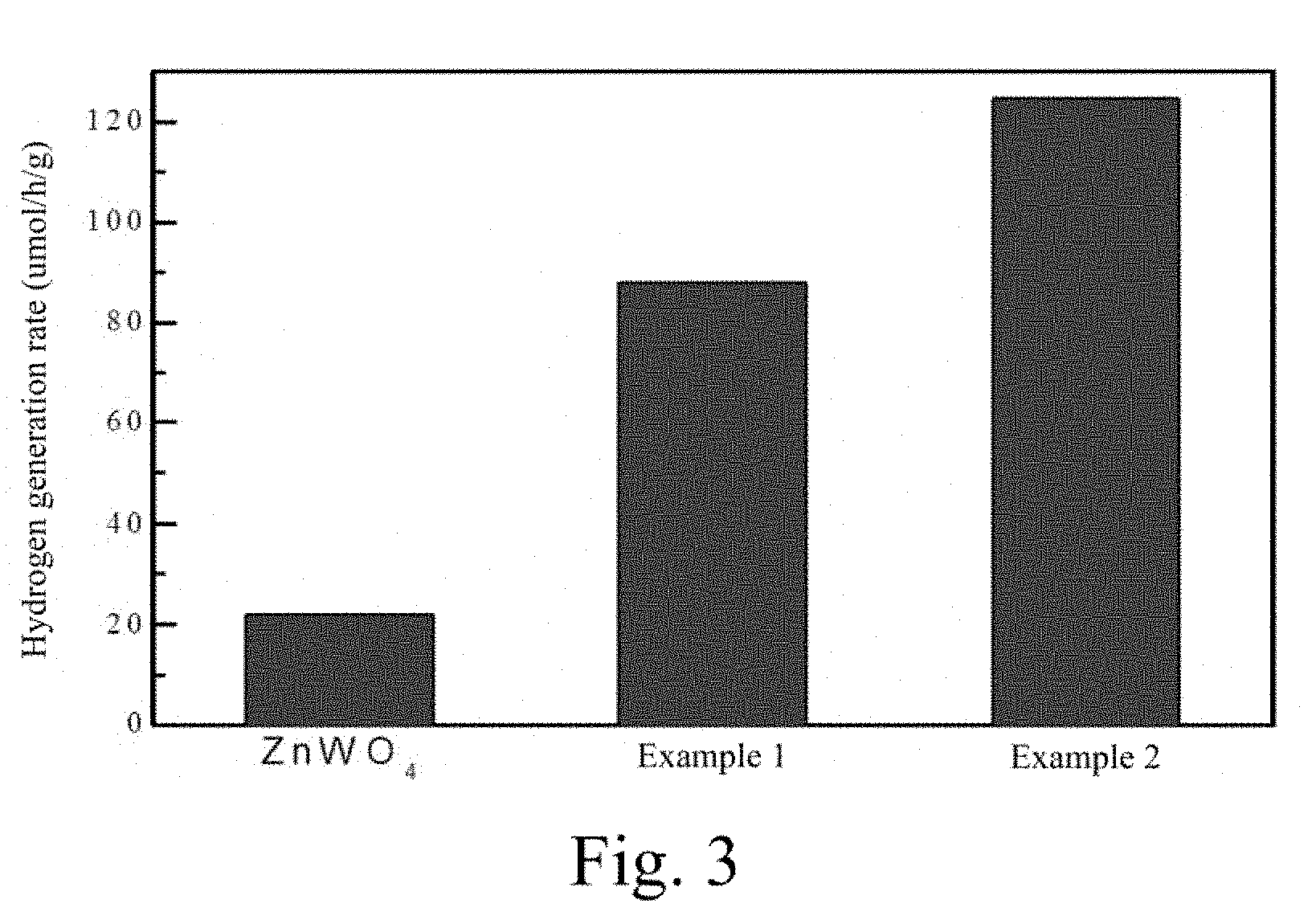ZnWO4 PHOTOCATALYTIC MATERIAL WITH OXYGEN VACANCY AND PREPARATION METHOD THEREOF
QI; Xiuxiu ; et al.
U.S. patent application number 16/083788 was filed with the patent office on 2019-03-21 for znwo4 photocatalytic material with oxygen vacancy and preparation method thereof. The applicant listed for this patent is CHANGZHOU VOCATIONAL INSTITUTE OF ENGINEERING. Invention is credited to Wenhua CHEN, Yaozhong LI, Xiuxiu QI, Yong ZHOU.
| Application Number | 20190083958 16/083788 |
| Document ID | / |
| Family ID | 57352996 |
| Filed Date | 2019-03-21 |



| United States Patent Application | 20190083958 |
| Kind Code | A1 |
| QI; Xiuxiu ; et al. | March 21, 2019 |
ZnWO4 PHOTOCATALYTIC MATERIAL WITH OXYGEN VACANCY AND PREPARATION METHOD THEREOF
Abstract
The invention belongs to the field of novel photocatalytic materials, and particularly relates to a ZnWO4 photocatalytic material containing oxygen vacancy. According to the material, absorption exists in a near infrared region of an ultraviolet-visible light diffuse reflection spectrum, wherein the wavelength range of the near infrared region is 780-2500 nm. The invention further relates to a preparation method of the ZnWO4 photocatalytic material containing oxygen vacancy. Na2WO4 and soluble zinc salt are used as raw materials, ZnWO4 crystals are formed through a hydrothermal crystallization reaction and then roasted in the presence of hydrogen so as to achieve partial reduction of ZnWO4, and then the ZnWO4 photocatalytic material containing oxygen vacancy is obtained.
| Inventors: | QI; Xiuxiu; (Changzhou, Jiangsu, CN) ; CHEN; Wenhua; (Changzhou, Jiangsu, CN) ; ZHOU; Yong; (Changzhou, Jiangsu, CN) ; LI; Yaozhong; (Changzhou, Jiangsu, CN) | ||||||||||
| Applicant: |
|
||||||||||
|---|---|---|---|---|---|---|---|---|---|---|---|
| Family ID: | 57352996 | ||||||||||
| Appl. No.: | 16/083788 | ||||||||||
| Filed: | June 30, 2016 | ||||||||||
| PCT Filed: | June 30, 2016 | ||||||||||
| PCT NO: | PCT/CN2016/087808 | ||||||||||
| 371 Date: | September 10, 2018 |
| Current U.S. Class: | 1/1 |
| Current CPC Class: | B01J 23/30 20130101; B01J 35/004 20130101; B01J 2523/27 20130101; C02F 2305/10 20130101; C01G 41/00 20130101; B01J 37/10 20130101; B01J 2523/69 20130101; C01P 2002/84 20130101; C01P 2002/72 20130101; B01J 35/002 20130101 |
| International Class: | B01J 23/30 20060101 B01J023/30; B01J 37/10 20060101 B01J037/10; B01J 35/00 20060101 B01J035/00 |
Foreign Application Data
| Date | Code | Application Number |
|---|---|---|
| Jun 21, 2016 | CN | 201610452354.9 |
Claims
1. A ZnWO.sub.4 photocatalytic material containing oxygen vacancy, characterized in that absorption exists in a near infrared region of an ultraviolet-visible light diffuse reflection spectrum of the material, wherein a wavelength range of the near infrared region is 780-2500 nm.
2. The ZnWO.sub.4 photocatalytic material containing oxygen vacancy of claim 1, characterized in that ZnWO.sub.4 is roasted in the presence of hydrogen so as to achieve partial reduction of ZnWO.sub.4, and then the ZnWO.sub.4 photocatalytic material containing oxygen vacancy is obtained.
3. The ZnWO.sub.4 photocatalytic material containing oxygen vacancy of claim 2, characterized in that a roasting temperature is 350-600 DEG C., and a roasting time is 1-4 h.
4. The ZnWO.sub.4 photocatalytic material containing oxygen vacancy of claim 2, characterized in that a temperature increasing rate during roasting is 1-5 DEG C./min.
5. A preparation method of the ZnWO.sub.4 photocatalytic material containing oxygen vacancy, characterized in that Na.sub.2WO.sub.4 and soluble zinc salt are used as raw materials, ZnWO.sub.4 crystals are formed through a hydrothermal crystallization reaction and then roasted in the presence of hydrogen so as to achieve partial reduction of ZnWO.sub.4, and then the ZnWO.sub.4 photocatalytic material containing oxygen vacancy is obtained.
6. The preparation method of claim 5, characterized in that the soluble zinc salt is ZnCl.sub.2, Zn(CH.sub.3COO).sub.2 or Zn(NO.sub.3).sub.2, with a concentration range in hydrothermal crystallization mother liquor being 0.001-0.1 mol/L.
7. The preparation method of claim 5, characterized in that the temperature range of the hydrothermal crystallization reaction is 120-200 DEG C., and a hydrothermal crystallization reaction time is 12-36 h.
8. The preparation method of claim 5, characterized in that an introduction amount of oxygen vacancy is changed by regulating the roasting temperature and a reduction time.
Description
TECHNICAL FIELD
[0001] The invention belongs to the field of novel photocatalytic materials, and particularly relates to a ZnWO.sub.4 photocatalytic material containing oxygen vacancy and a preparation method thereof.
BACKGROUND ART
[0002] With the growing consumption of fossil fuels, energy crises and environmental problems are caused, which increasingly limit the development of human societies, so that there is no delay in looking for alternative energy sources. Efficient and convenient utilization, conversion and storage of solar energy facilitate solving energy and environmental problems. A photocatalysis technology is a method of directly converting solar energy into chemical energy in the presence of a photocatalytic material. The photocatalysis technology can be used for hydrogen production by water decomposition and degradation of organic pollutants, and a reaction process is green and convenient, so that the photocatalysis technology has a great application prospect and provides new ideas for solving the energy crisis and environmental problems. Typical photocatalytic materials are mostly semiconductors, including TiO.sub.2, ZnO, WO.sub.3, CdS, BiVO.sub.4, etc. While when these semiconductor materials are applied to a photocatalytic process, the problems of weak absorption of visible light, differential charge separation, photocorrosion, etc. often exist.
[0003] Transition metal tungstate, ZnWO.sub.4, is a wide bandgap (>3.6 eV) semiconductor photocatalytic material featuring by high electron transport rate and long life of a photon-generated carrier. The ZnWO.sub.4 photocatalytic material has extensive application prospects in the fields of photocatalytic degradation of organic pollutants, photocatalytic hydrogen production, photoluminescence materials, etc. However, the too wide bandgap of the ZnWO.sub.4 photocatalytic material limits the photocatalytic capacity of the ZnWO.sub.4 photocatalytic material under visible light, mainly reflected in the problems that the ZnWO.sub.4 photocatalytic material is narrow in light absorption range and poor in charge separation.
[0004] The invention is intended to solve the foregoing problems.
SUMMARY OF THE INVENTION
[0005] The invention provides a ZnWO.sub.4 photocatalytic material containing oxygen vacancy in a first aspect. According to the material, absorption exists in a near infrared region of an ultraviolet-visible light diffuse reflection spectrum, and the wavelength range of the near infrared region is 780-2500 nm.
[0006] ZnWO.sub.4 is roasted in the presence of hydrogen so as to achieve partial reduction of ZnWO.sub.4, and then the ZnWO.sub.4 photocatalytic material containing oxygen vacancy is obtained.
[0007] Preferably, the roasting temperature is 350-600 DEG C. and the roasting time is 1-4 h.
[0008] Preferably, the temperature increasing rate during roasting is 1-5 DEG C./min.
[0009] The invention provides a preparation method of the ZnWO.sub.4 photocatalytic material containing oxygen vacancy in a second aspect. According to the preparation method, Na2WO.sub.4 and soluble zinc salt are used as raw materials, ZnWO.sub.4 crystals are formed through a hydrothermal crystallization reaction and then roasted in the presence of hydrogen so as to achieve partial reduction of ZnWO.sub.4, and then the ZnWO.sub.4 photocatalytic material containing oxygen vacancy is obtained.
[0010] Preferably, the soluble zinc salt is ZnCl.sub.2, Zn(CH.sub.3COO).sub.2 or Zn(NO.sub.3).sub.2, with the concentration range in hydrothermal crystallization mother liquor being 0.001-0.1 mol/L.
[0011] Preferably, the temperature range of the hydrothermal crystallization reaction is 120-200 DEG C., and the hydrothermal crystallization reaction time is 12-36 h.
[0012] In the invention, a typical ZnWO.sub.4 photocatalytic material is synthesized by a hydrothermal process, and the oxygen vacancy is introduced by roasting and reducing in the presence of hydrogen, so that the ZnWO.sub.4 photocatalytic material with oxygen vacancy is obtained, and the introduction amount of the oxygen vacancy is changed by regulating the roasting reduction temperature and time.
[0013] The specific preparation scheme is as follows:
[0014] (1) synthesis of a typical ZnWO.sub.4 photocatalytic material by a hydrothermal process: by taking deionized water as a solvent, a 0.001-0.1 mol/L slat solution of zinc (ZnCl.sub.2, Zn(CH.sub.3COO).sub.2 and Zn(NO.sub.3).sub.2) is mixed with a Na.sub.2WO.sub.4 solution having equivalent volume and concentration, stirring is carried out continuously for 30 min, and then a white suspension is obtained; the obtained white suspension is put in a hydrothermal reaction kettle, a reaction undergoes at 120-200 DEG C. for 12-36 h, and then cooling to room temperature is carried out; and then, a solid product in the hydrothermal reaction kettle is separated out and is washed with deionized water and ethanol for three times respectively, and subsequently drying and grinding are carried out, so that a corresponding ZnWO.sub.4 photocatalytic material is obtained; and
[0015] (2) preparation of the ZnWO.sub.4 photocatalytic material containing oxygen vacancy by roasting and reducing in the presence of hydrogen: the obtained typical ZnWO.sub.4 photocatalytic material is put in a crucible, and is roasted in an atmosphere furnace under a hydrogen atmosphere at 350-600 DEG C. for 1-4 h, with the temperature increasing rate during roasting being 1-5 DEG C./min, and finally an obtained product is the ZnWO.sub.4 photocatalytic material containing oxygen vacancy. The ZnWO.sub.4 photocatalytic material containing oxygen vacancy and the preparation method have the following benefits:
[0016] (1) the visible light absorption capacity of ZnWO.sub.4 is improved by introducing the oxygen vacancy, and the photocatalytic performance of ZnWO.sub.4 is further improved; and
[0017] (2) the introduction amount of the oxygen vacancy can be regulated by changing the roasting and reduction time and temperature in the presence of hydrogen, so that the ZnWO.sub.4 photocatalytic material containing oxygen vacancy meet the requirements of different application scenes.
BRIEF DESCRIPTION OF THE DRAWINGS
[0018] FIG. 1 is an X-ray diffraction spectrogram of a ZnWO.sub.4 photocatalytic material containing oxygen vacancy.
[0019] FIG. 2 is an ultraviolet-visible light diffuse reflection spectrum (UV-VIS spectrum) of the ZnWO.sub.4 photocatalytic material containing oxygen vacancy.
[0020] FIG. 3 shows the photocatalytic hydrogen production performance of the ZnWO.sub.4 photocatalytic material containing oxygen vacancy in a lactic acid solution.
DETAILED DESCRIPTION OF THE INVENTION
[0021] The invention will be further described below in conjunction with the accompanying drawings and specific embodiments, and all used drugs are from commercial sources.
Example 1
[0022] (1) Synthesis of a typical ZnWO.sub.4 photocatalytic material by a hydrothermal process: by taking deionized water as a solvent, 4 mmol Zn(CH.sub.3COO).sub.2 and 4 mmol Na.sub.2WO.sub.4 are dissolved in 40 mL deionized water respectively, and a solution A and a solution B are obtained; the solution B is dropwise added to the solution A with stirring, the stirring is carried out continuously for 30 min, and then a white suspension is obtained; the obtained white suspension is put in a 100 mL hydrothermal reaction kettle, the hydrothermal reaction kettle is put in an oven, a thermostatic reaction undergoes at 180 DEG C. for 24 h, and then cooling to temperature is carried out; and then, a solid product in the hydrothermal reaction kettle is separated out by centrifugation and is washed with deionized water and ethanol for three times respectively, and subsequently drying and grinding are carried out, so that a corresponding ZnWO.sub.4 photocatalytic material is obtained; and (2) preparation of the ZnWO.sub.4 photocatalytic material containing oxygen vacancy by roasting and reducing in the presence of hydrogen: the obtained typical ZnWO.sub.4 photocatalytic material is put in a crucible, and is roasted in an atmosphere furnace under a hydrogen atmosphere at 400 DEG C. for 2 h, with the temperature increasing rate during roasting being 2 DEG C./min, and finally an obtained product is the ZnWO.sub.4 photocatalytic material containing oxygen vacancy.
Example 2
[0023] (1) Synthesis of a typical ZnWO.sub.4 photocatalytic material by a hydrothermal process: by taking deionized water as a solvent, 2 mmol ZnCl.sub.2 and 2 mmol Na.sub.2WO.sub.4 are dissolved in 40 mL deionized water respectively, and a solution A and a solution B are obtained; the solution B is dropwise added to the solution A with stirring, the stirring is carried out continuously for 30 min, and then a white suspension is obtained; the obtained white suspension is put in a 100 mL hydrothermal reaction kettle, the hydrothermal reaction kettle is put in an oven, a thermostatic reaction undergoes at 150 DEG C. for 24 h, and then cooling to temperature is carried out; and then, a solid product in the hydrothermal reaction kettle is separated out by centrifugation and is washed with deionized water and ethanol for three times respectively, and subsequently drying and grinding are carried out, so that a corresponding ZnWO.sub.4 photocatalytic material is obtained; and (2) preparation of the ZnWO.sub.4 photocatalytic material containing oxygen vacancy by roasting and reducing in the presence of hydrogen: the obtained typical ZnWO.sub.4 photocatalytic material is put in a crucible, and is roasted in an atmosphere furnace under a hydrogen atmosphere at 500 DEG C. for 4 h, with the temperature increasing rate during roasting being 2 DEG C./min, and finally an obtained product is the ZnWO.sub.4 photocatalytic material containing oxygen vacancy.
Example 3
[0024] Example 3 is a spectroscopy characterization and activity experiment on the ZnWO.sub.4 photocatalytic material containing oxygen vacancy and a common ZnWO.sub.4 photocatalytic material.
[0025] FIG. 1 is an X-ray diffraction spectrogram of the ZnWO.sub.4 photocatalytic material containing oxygen vacancy and the common ZnWO.sub.4 photocatalytic material which are prepared on the conditions of the example 1 and the example 2. It can be observed that the X-ray diffraction peak intensity after the oxygen vacancy is introduced is weakened generally.
[0026] FIG. 2 is an ultraviolet-visible light diffuse reflection spectrum of the ZnWO.sub.4 photocatalytic material containing oxygen vacancy and the common ZnWO.sub.4 photocatalytic material which are prepared on the conditions of the example 1 and the example 2. It can be observed that absorption of ZnWO.sub.4 with the oxygen vacancy exists in a near infrared region, which shows that the oxygen vacancy exist in the material.
[0027] FIG. 3 is a performance evaluation experiment on the ZnWO.sub.4 photocatalytic material containing oxygen vacancy and the common ZnWO.sub.4 photocatalytic material, prepared on the conditions of the example 1 and the example 2, applied to a lactic acid photocatalytic hydrogen production reaction. The horizontal axis is reaction time and the longitudinal axis is a hydrogen evolution rate. Obviously, the activity of the ZnWO.sub.4 photocatalytic material containing oxygen vacancy in the example 1 is increased by about 4 times compared with that of the typical ZnWO.sub.4 photocatalytic material, and the activity of the ZnWO.sub.4 photocatalytic material containing oxygen vacancy in the example 2 is increased by about 6 times compared with that of the typical ZnWO.sub.4 photocatalytic material, which shows that after the oxygen vacancy is introduced, the ZnWO.sub.4 photocatalytic activity is improved greatly.
* * * * *
D00000

D00001

D00002

XML
uspto.report is an independent third-party trademark research tool that is not affiliated, endorsed, or sponsored by the United States Patent and Trademark Office (USPTO) or any other governmental organization. The information provided by uspto.report is based on publicly available data at the time of writing and is intended for informational purposes only.
While we strive to provide accurate and up-to-date information, we do not guarantee the accuracy, completeness, reliability, or suitability of the information displayed on this site. The use of this site is at your own risk. Any reliance you place on such information is therefore strictly at your own risk.
All official trademark data, including owner information, should be verified by visiting the official USPTO website at www.uspto.gov. This site is not intended to replace professional legal advice and should not be used as a substitute for consulting with a legal professional who is knowledgeable about trademark law.